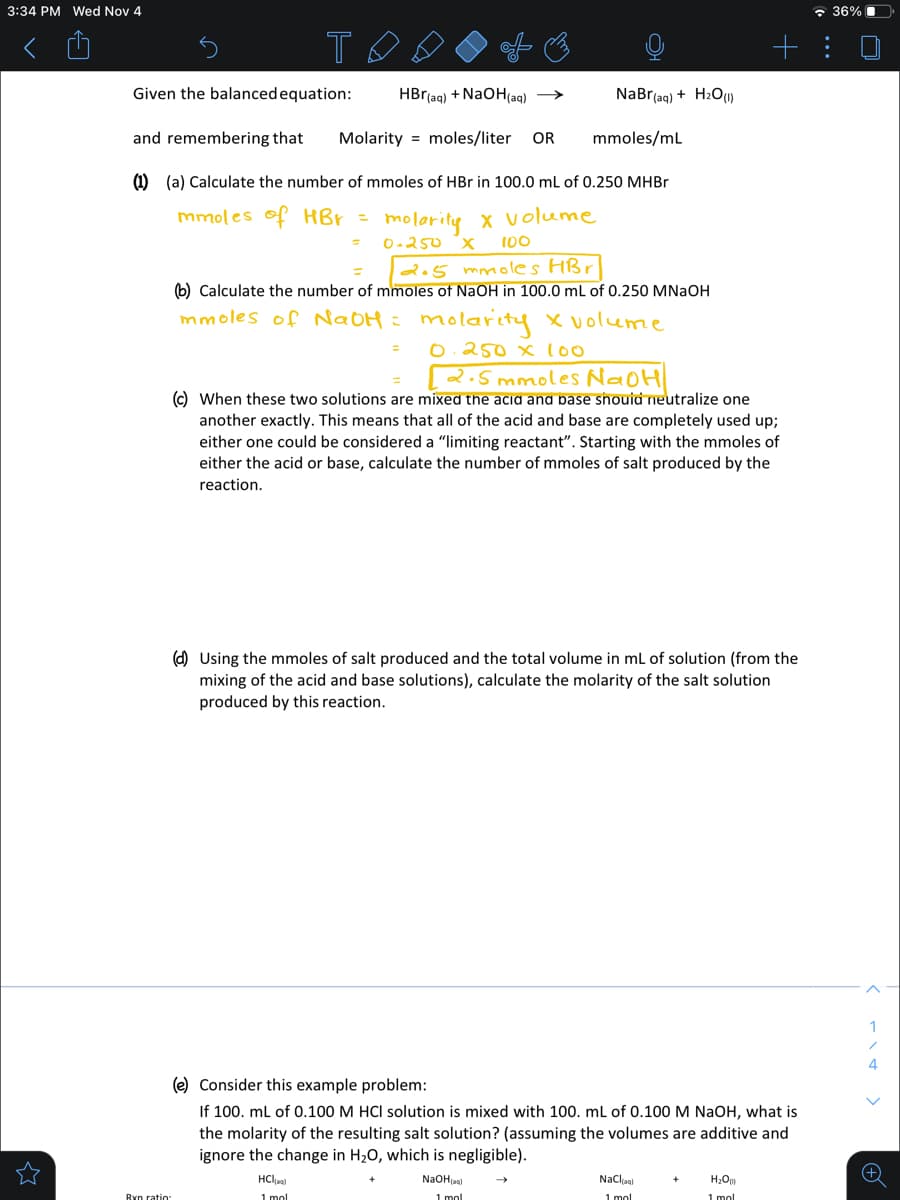Given the balancedequation: HBr(aq) + NaOH(aq) NaBr(aq) + H2O) and remembering that Molarity = moles/liter OR mmoles/mL (1) (a) Calculate the number of mmoles of HBr in 100.0 ml of 0.250 MHBR mmoles of HBr = molarity x volume = 0.250 x 100 2o5 mmoles HBr (b) Calculate the number of mmoles of NaOH in 100.0 mL of 0.250 MNaOH mmoles of NAOH: molarity 0.250 x 100 2.5 mmoles NaOH x volueme (c) When these two solutions are mixed the acid and base shouid neutralize one another exactly. This means that all of the acid and base are completely used up; either one could be considered a "limiting reactant". Starting with the mmoles of either the acid or base, calculate the number of mmoles of salt produced by the reaction.
Given the balancedequation: HBr(aq) + NaOH(aq) NaBr(aq) + H2O) and remembering that Molarity = moles/liter OR mmoles/mL (1) (a) Calculate the number of mmoles of HBr in 100.0 ml of 0.250 MHBR mmoles of HBr = molarity x volume = 0.250 x 100 2o5 mmoles HBr (b) Calculate the number of mmoles of NaOH in 100.0 mL of 0.250 MNaOH mmoles of NAOH: molarity 0.250 x 100 2.5 mmoles NaOH x volueme (c) When these two solutions are mixed the acid and base shouid neutralize one another exactly. This means that all of the acid and base are completely used up; either one could be considered a "limiting reactant". Starting with the mmoles of either the acid or base, calculate the number of mmoles of salt produced by the reaction.
Chemistry: Principles and Reactions
8th Edition
ISBN:9781305079373
Author:William L. Masterton, Cecile N. Hurley
Publisher:William L. Masterton, Cecile N. Hurley
Chapter10: Solutions
Section: Chapter Questions
Problem 5QAP: Silver ions can be found in some of the city water piped into homes. The average concentration of...
Related questions
Question

Transcribed Image Text:3:34 PM Wed Nov 4
* 36% I
Given the balancedequation:
HBr(aq) + NAOH(aq) →
NaBr(aq) + H2OU»
and remembering that
Molarity = moles/liter
OR
mmoles/mL
(1) (a) Calculate the number of mmoles of HBr in 100.0 ml of 0.250 MHBR
mmoles of HBr = molarity x volume
O-250 x
100
205 mmoles HBr
(6) Calculate the number of mmoles of NaOH in 100.0 mL of 0.250 MNAOH
mmoles of NaOH = molo
Lolarity olume
0.250 x l00
%3D
2.5 mmoles NaoH
© When these two solutions are mixed the acid and pase snouid neutralize one
another exactly. This means that all of the acid and base are completely used up;
either one could be considered a "limiting reactant". Starting with the mmoles of
either the acid
base, calculate
number of mmoles of salt produced by the
reaction.
(d) Using the mmoles of salt produced and the total volume in mL of solution (from the
mixing of the acid and base solutions), calculate the molarity of the salt solution
produced by this reaction.
1
4
(e) Consider this example problem:
If 100. ml of 0.100 M HCI solution is mixed with 100. ml of 0.100 M NaOH, what is
the molarity of the resulting salt solution? (assuming the volumes are additive and
ignore the change in H20, which is negligible).
HClaa)
NaOHjaal
Naclja)
I mol
1 mol
1 mol
1 mol
Ryn ratio:
Expert Solution
This question has been solved!
Explore an expertly crafted, step-by-step solution for a thorough understanding of key concepts.
This is a popular solution!
Trending now
This is a popular solution!
Step by step
Solved in 3 steps with 1 images

Knowledge Booster
Learn more about
Need a deep-dive on the concept behind this application? Look no further. Learn more about this topic, chemistry and related others by exploring similar questions and additional content below.Recommended textbooks for you

Chemistry: Principles and Reactions
Chemistry
ISBN:
9781305079373
Author:
William L. Masterton, Cecile N. Hurley
Publisher:
Cengage Learning

Introduction to General, Organic and Biochemistry
Chemistry
ISBN:
9781285869759
Author:
Frederick A. Bettelheim, William H. Brown, Mary K. Campbell, Shawn O. Farrell, Omar Torres
Publisher:
Cengage Learning

Chemistry: Principles and Reactions
Chemistry
ISBN:
9781305079373
Author:
William L. Masterton, Cecile N. Hurley
Publisher:
Cengage Learning

Introduction to General, Organic and Biochemistry
Chemistry
ISBN:
9781285869759
Author:
Frederick A. Bettelheim, William H. Brown, Mary K. Campbell, Shawn O. Farrell, Omar Torres
Publisher:
Cengage Learning